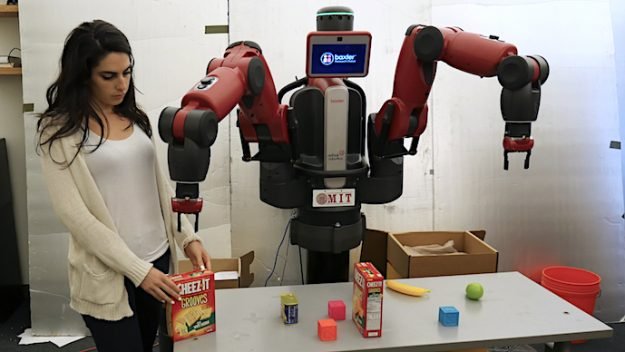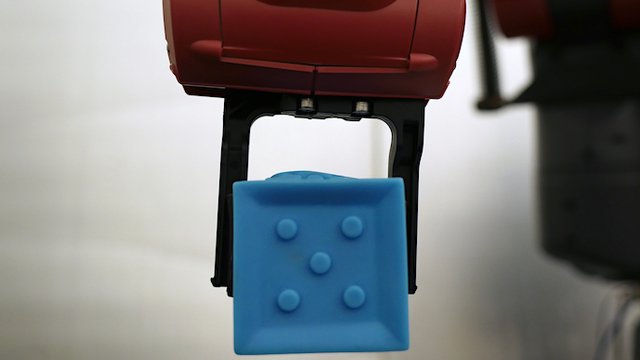
The integration of robotics and AI is picking up pace and one of the biggest contributors to research conducted on an annual basis is MIT, home to some of the most intelligent computer engineering and programming specialists in the world.
In this article we will look at a recent breakthrough MIT just made in the field of contextual commands. As technologies like Alexa (the digital personal assistant) get better and better so does the programming of competition, learning from Alexa and expanding on it.
Ask your cyborg butler, for instance, to pick up a specific tool from a toolbox, and “it would be completely lost,” according to the Massachusetts Institute of Technology.
“Picking it up means being able to see and identify objects, understand commands, recognize that the ‘it’ in question is the tool you put down, go back in time to remember the moment when you put down the tool, and distinguish the tool you put down from other ones of similar shapes and sizes,” the academy said.
Researchers from MIT’s Computer Science and Artificial Intelligence Laboratory (CSAIL), however, are making progress in this area.
Take a look at this interesting video of MIT showing off some of its recent developments in AI and robotics:
At MIT, researchers created a team called ComText (“commands in context”), an Amazon Alexa-like system that enables robots to understand commands that require contextual knowledge.
“Where humans understand the world as a collection of objects and people and abstract concepts, machines view it as pixels, point-clouds, and 3D maps generated from sensors,” CSAIL postdoc Rohan Paul, one of the lead authors of the paper, said in a statement.

To us this is just a block and if someone asked us to pick it up it would be a very simple task. However, programming a robot to be able to complete the same task is an incredibly difficult and time consuming challenge.
While most machine learning focuses only on semantic memory (general knowledge), MIT believes that androids should have “different kinds of memory, just like people,” co-author and research scientist Andrei Barbu said.
So the team is training its computer to retain personal facts, or episodic memory—an object’s shape, size, position, type. This adds another layer of intelligence, and allows ComText to reason, infer meaning, and respond to commands.
This added layer of information acts as a sort of contextual understanding for AI and enables it to have a deeper understanding of a task or challenge.
Techblogger Wrap Up
Did you think that AI would be something you would see integrated to everyday life in your lifetime? Do you think these developments will continue to affect consumer products in coming months and years?
If you answered yes to both of these questions, then you and I are on the same page. Contextual knowledge will make AI seem more life-like and more intelligent. It will enable robots to complete many of the same tasks that we are able to complete and in doing so they will be able to compete with humans more effectively.
What are your thoughts on this? Please leave your comments and feedback below.
Thanks for reading!

Source:
Step Aside, Alexa: MIT Robot Follows Contextual Commands - Geek.com
The introduction of overlords...
Downvoting a post can decrease pending rewards and make it less visible. Common reasons:
Submit
The robotic field has made huge strides and will be a regular part of our lives. That said, people do not realize how much quicker the mental side of things moves. Dexterity is still a struggle for AI, intelligence is much easier.
Look for both to move forward at an exponential rate. However, the neural side of things will grow, in my view, at a faster pace.
Downvoting a post can decrease pending rewards and make it less visible. Common reasons:
Submit
Awesome advancement!! Robotics, Machine Learning and AI are the next big thing.
Downvoting a post can decrease pending rewards and make it less visible. Common reasons:
Submit
What I see.... I see soon we not have work . Thank you.
Downvoting a post can decrease pending rewards and make it less visible. Common reasons:
Submit
I'm very curious to see how the context-powered AI tech develops. If they can make big strides here, we'll be remarkably close to a "human" style AI.
Downvoting a post can decrease pending rewards and make it less visible. Common reasons:
Submit
a good new principle to facilitate human work
Downvoting a post can decrease pending rewards and make it less visible. Common reasons:
Submit
Congratulations @techblogger! You have completed some achievement on Steemit and have been rewarded with new badge(s) :
Click on any badge to view your own Board of Honor on SteemitBoard.
For more information about SteemitBoard, click here
If you no longer want to receive notifications, reply to this comment with the word
STOPDownvoting a post can decrease pending rewards and make it less visible. Common reasons:
Submit